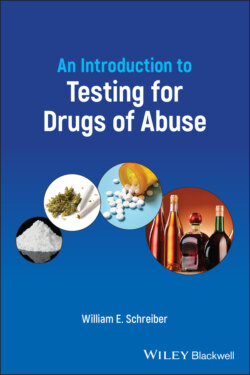Читать книгу An Introduction to Testing for Drugs of Abuse - William E. Schreiber - Страница 18
Why Test for Drugs of Abuse?
ОглавлениеThere are several fields of medicine in which drug testing is an essential part of diagnosis and monitoring.
Emergency medicine – patients with an acute intoxication may present with aggressive or bizarre behavior or an altered level of consciousness. Testing for alcohols and other substances in blood helps the physician to identify the cause and monitor treatment. Screening for drugs in urine can identify recent consumption of commonly abused drugs and assist in follow‐up care.
Addiction medicine – treatment of substance use disorders usually requires monitoring of patients for ongoing consumption of drugs. For example, patients on a methadone maintenance program are monitored to ensure that they are taking the methadone as prescribed and are not continuing to use other opioids. Treatment of alcohol use disorder includes testing for markers of alcohol consumption.
Pain management – opioids and other medications are prescribed to treat chronic pain syndromes. Patients may sell or divert their medications, becoming distributors of pharmaceutical‐grade drugs to others who misuse them. Regular testing is performed to ensure compliance with the treatment program and to check for use of nonprescribed medications.
Drug testing is also performed to promote safety in the workplace, support the legal system, and ensure fair competition in sports.
Workplace drug testing – drug use among employees is responsible for time lost from work and increased numbers of job‐related accidents. Intoxicated employees are more likely to cause injury or death to themselves, their coworkers and innocent third parties. The transportation industry regularly tests drivers, pilots, and other workers for drug use to maintain standards of safety and accountability. Cut‐off concentrations for initial and confirmatory tests are published by the United States Department of Transportation (Table 1.2).
Forensic toxicology – this term refers to drug analysis for legal purposes. Testing of drivers for ethanol and other drugs is used to establish intoxication, which may lead to arrest, prosecution, and civil or criminal penalties. People may be given drugs without their knowledge to incapacitate them for purposes of robbery or sex (drug‐facilitated assault). Analysis of the victim's blood or urine can identify such drugs. Toxicology is also a standard part of death investigations conducted by coroners and medical examiners. Postmortem analysis for drugs in blood, urine, and vitreous specimens is routinely performed to investigate a possible drug‐related cause of death.
Performance enhancement – elite athletes, both professional and amateur, want a competitive edge, and some of them find it in performance‐enhancing drugs. These drugs are taken to improve strength and stamina and are different from recreational drugs of abuse. Examples include anabolic steroids, human growth hormone, and erythropoietin. Performance‐enhancing drugs are banned from major sporting competitions. The ban is enforced by testing athletes on a sporadic basis and immediately following competition.
Table 1.2 Cut‐off concentrations for drugs and metabolites in urine.
Source: United States Department of Transportation www.transportation.gov/odapc/part40/40‐87
| Analyte | Initial test | Confirmatory test |
|---|---|---|
| Marijuana metabolite (THC‐COOH) | 50 | 15 |
| Cocaine metabolite (benzoylecgonine) | 150 | 100 |
| Codeine/morphine | 2000 | 2000 |
| Hydrocodone/hydromorphone | 300 | 100 |
| Oxycodone/oxymorphone | 100 | 100 |
| 6‐Acetylmorphine | 10 | 10 |
| Phencyclidine | 25 | 25 |
| Amphetamine/methamphetamine | 500 | 250 |
| MDMA/MDA | 500 | 250 |
These cut‐offs specify the minimum concentration of a drug or metabolite that constitutes a positive test. All concentrations are in ng/mL. Samples with a positive initial test must undergo a confirmatory test before reporting the result. Grouped analytes such as codeine/morphine are both detected in the initial test, but they are measured and reported separately in the confirmatory test.
3,4‐methylenedioxyamphetamine; MDMA, 3,4‐methylenedioxymethamphetamine; THC‐COOH, delta‐9‐tetrahydrocannabinol‐9‐carboxylic acid.
